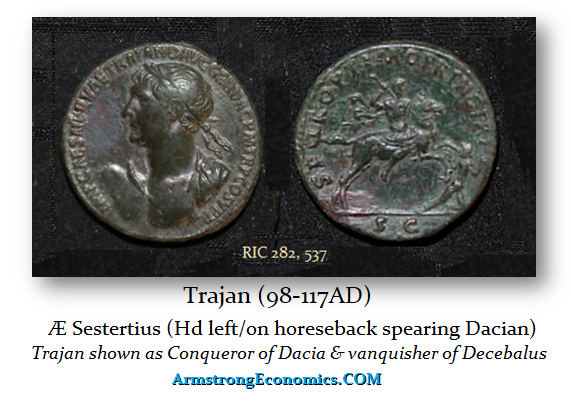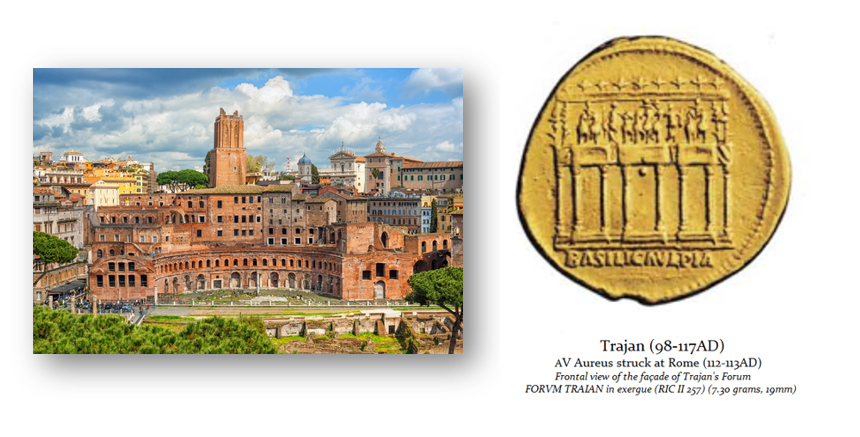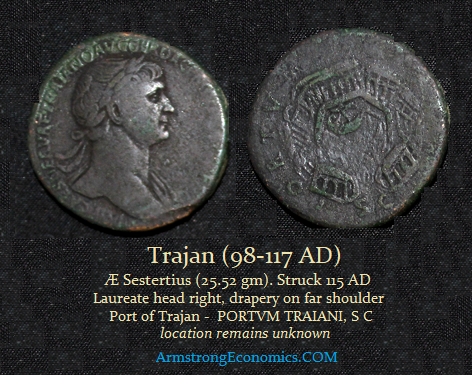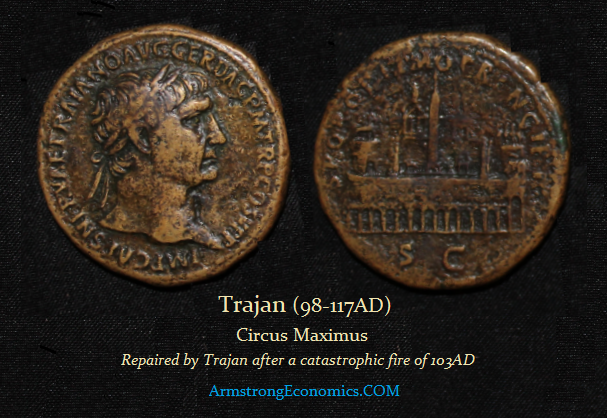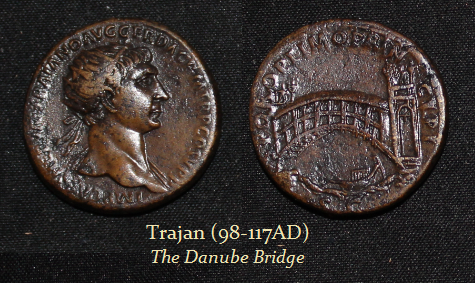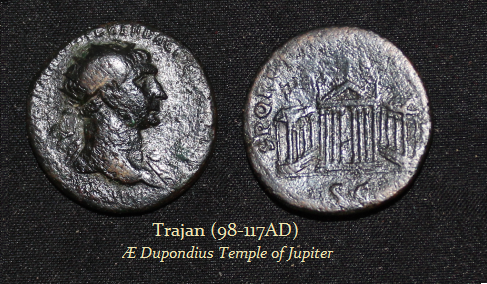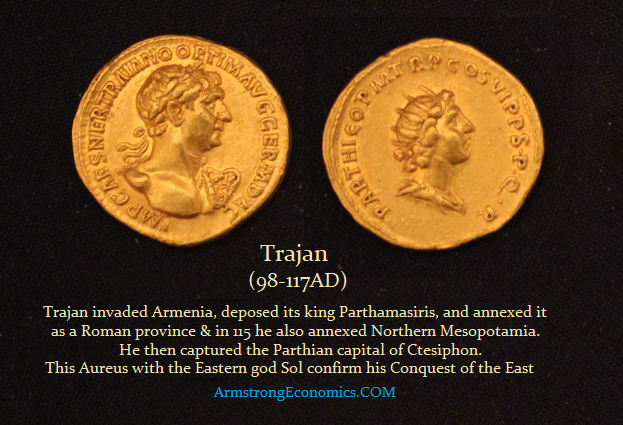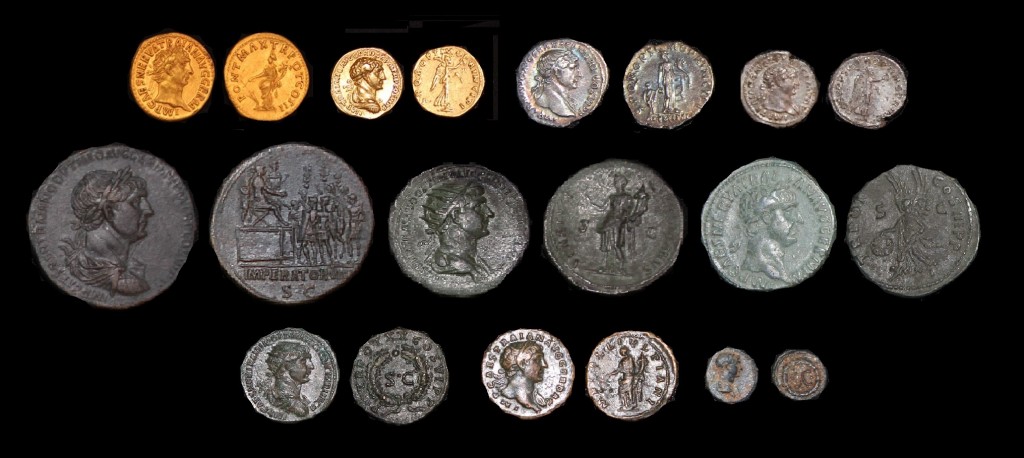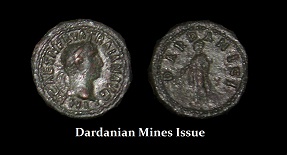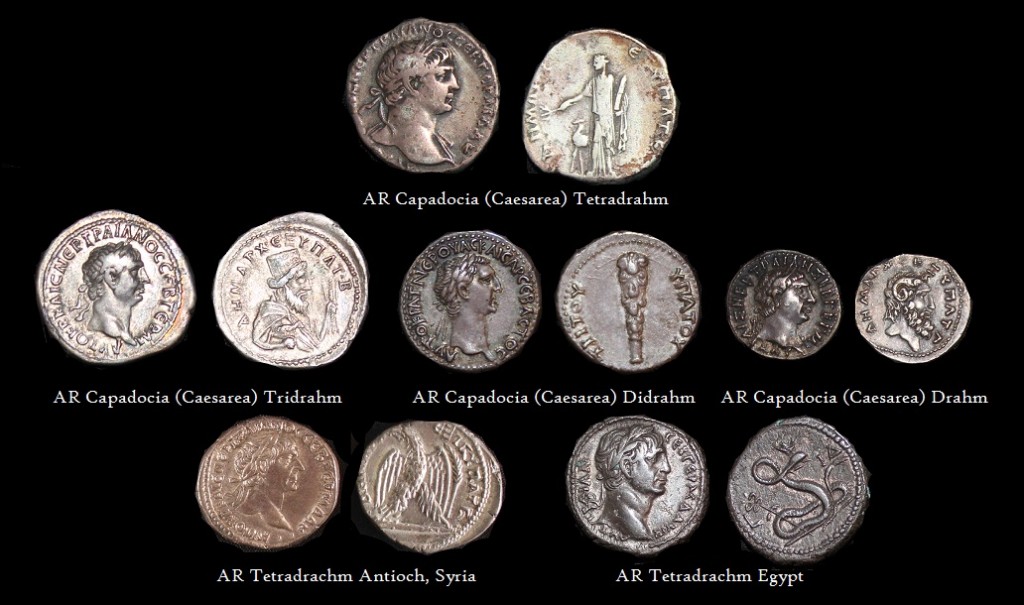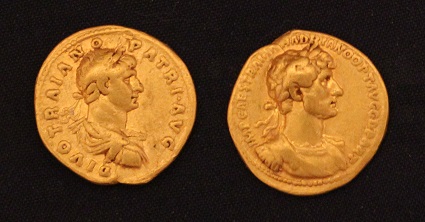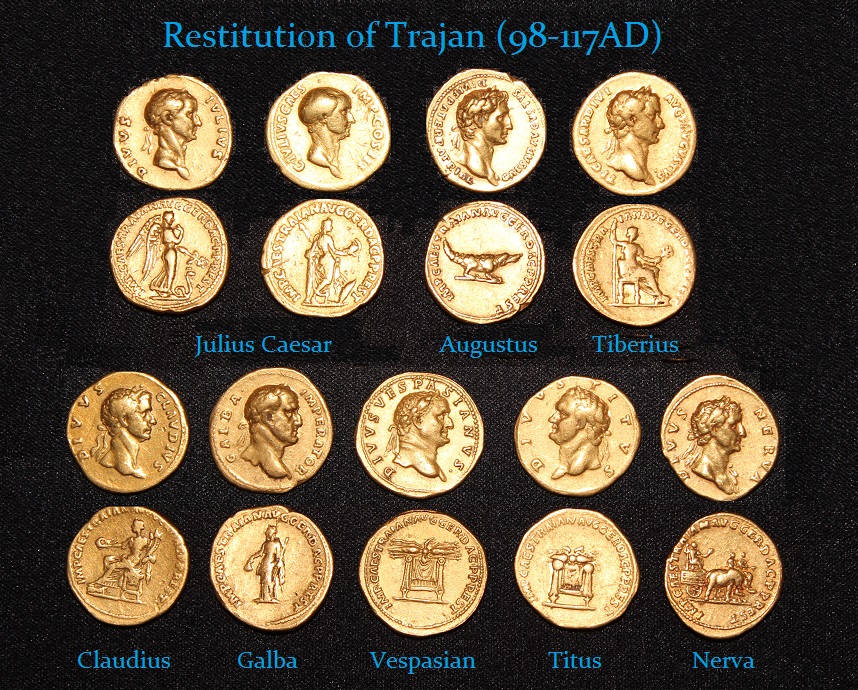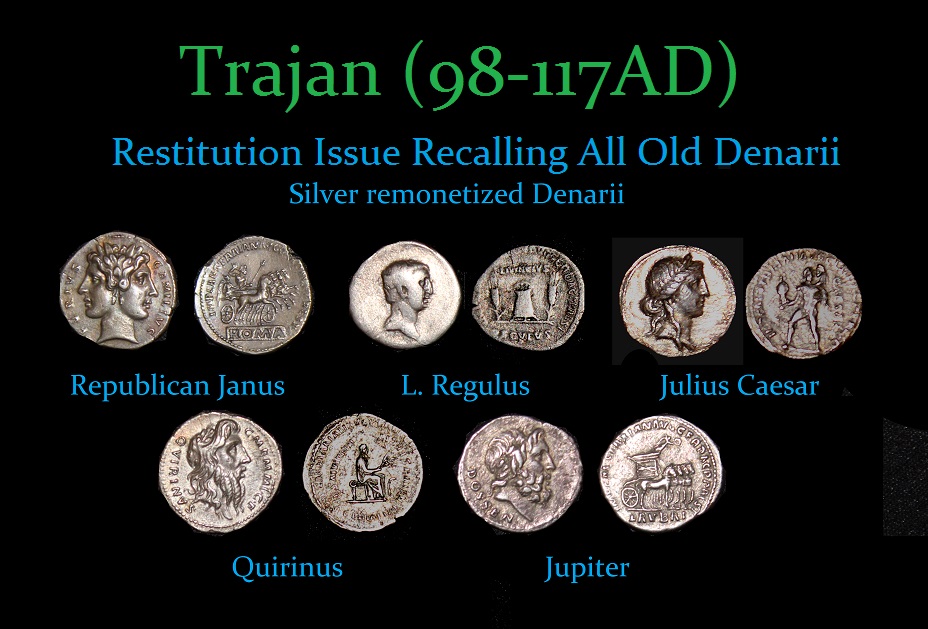Trajan

Emperor, 98 – 117 AD
Born 52 – Died 117 AD, Age 65
Marcus Ulpius Trajanus was born in Italica in Spain about the year 52 AD. His family was originally from Umbria in Italy. His father, of the same name, was a senator and had served as consul. He was also governor of Asia and Syria at one time. His mother was Marcia, but unfortunately, nothing is known about her background. Ulpia Marciana was the older sister of Trajan, and when she died, he issued a series of commemorative coinage from gold, silver, and bronze.
 In Spain, Trajan had early rigorous military training in the frontier provinces holding several important military posts. Eventually, Trajan was appointed Consul in 91AD and was appointed Governor of Upper Germany by Emperor Nerva. Trajan’s reputation for the efficient administration of Upper Germany and support of the military greatly impressed Emperor Nerva, which had much to do with his adoption by Nerva as the heir to the imperial throne.
In Spain, Trajan had early rigorous military training in the frontier provinces holding several important military posts. Eventually, Trajan was appointed Consul in 91AD and was appointed Governor of Upper Germany by Emperor Nerva. Trajan’s reputation for the efficient administration of Upper Germany and support of the military greatly impressed Emperor Nerva, which had much to do with his adoption by Nerva as the heir to the imperial throne.
Following the death of Nerva, Trajan’s first goal was to strengthen the frontier defenses between the headwaters of the Rhine and the Danube. Trajan then set out for Rome arriving in the city around 100 AD. He immediately set about strengthening his political power base by winning the support and confidence of the Senate as well as the citizens of Rome itself. Trajan’s good character, wisdom, and affable personality aided him greatly in accomplishing that goal. His deep respect for constitutional government and the fairness of law was quite apparent to everyone.
When the Trajan came to power in 98AD following the death of Nerva, King Decebalus of Dacia had become a threat to the Roman Empire defeating several of Rome’s legions during the reign of Domitian (81–96AD). Trajan gained the support of the people and the Senate to wage war against Dacia (modern-day Balkans).
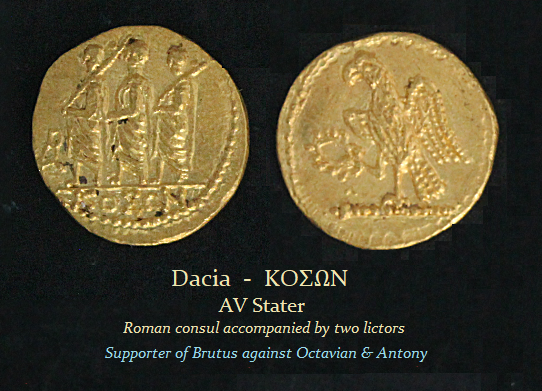 Consequently, Trajan’s Dacia War like all those of modern times, set in motion a serious financial crisis in the form of inflation. When Trajan came to power, the silver denarius stood at 93.5% pure. The First Roman–Dacian War broke out in 101AD and continued into 102AD. This is when we see the first reduction in the fineness of the denarius by about 1% down to 92.75%. A peace treaty reached by the Dacian king was not trustworthy. He negotiated for peace only to buy time to rebuild his army.
Consequently, Trajan’s Dacia War like all those of modern times, set in motion a serious financial crisis in the form of inflation. When Trajan came to power, the silver denarius stood at 93.5% pure. The First Roman–Dacian War broke out in 101AD and continued into 102AD. This is when we see the first reduction in the fineness of the denarius by about 1% down to 92.75%. A peace treaty reached by the Dacian king was not trustworthy. He negotiated for peace only to buy time to rebuild his army.
Burebista was the king of Dacia, but he was also assassinated in 44BC as was Julius Caesar. Thereafter, Dacia split into several small states. One of these states was ruled by Koson, who was allied with Brutus in his war against Octavian and Mark Antony. His coinage in gold mimics that of Brutus. A hoard of gold coins was found in the ruins of Sarmizegetusa.
The Second Roman–Dacian War was fought between 105AD and 106AD because the Dacian king, Diurpaneus took the name of Decebalus (“The Mighty One”) after defeating Domitian’s forces. Decebalus had broken his peace terms with Rome. As the cost of preparing, for now, a major war against Dacia is reflected in the coinage in advance. Trajan again reduced the fineness of the denarius in 103AD down to 91.5%.
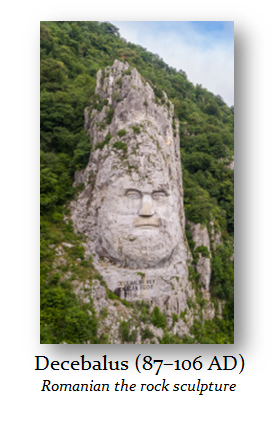 This sestertius of Trajan presents him in the style of a heroic bust reminiscent of Hercules the Conqueror. The reverse inscription identifies him as Optimo Principi, the best of emperors. This coin was most likely struck in 107AD as part of his triumph awarded him for his victory in the Second Dacian War in 106AD. Here we see Tiberius Claudius Maximus from Legio VII Claudia hunting down the Dacian king Decebalus, who committed suicide rather than be paraded as a trophy in Rome. This conquest was commemorated by his famous column which still stands today in Rome.
This sestertius of Trajan presents him in the style of a heroic bust reminiscent of Hercules the Conqueror. The reverse inscription identifies him as Optimo Principi, the best of emperors. This coin was most likely struck in 107AD as part of his triumph awarded him for his victory in the Second Dacian War in 106AD. Here we see Tiberius Claudius Maximus from Legio VII Claudia hunting down the Dacian king Decebalus, who committed suicide rather than be paraded as a trophy in Rome. This conquest was commemorated by his famous column which still stands today in Rome.
Still, Decebalus’ head was taken back and displayed in Rome. Cassius Dio tells us that Trajan took great pride in having been awarded the cognomen Optimus, valuing it above all other titles combined. The historian Pliny reports that upon future emperors rising to the throne, the Senate addressed them with the well-wish that they might be felicior Augusto, Trajano melior (“Happier than Augustus, better than Trajan”).
Nevertheless, the spirit of Decebalus was revived in recent years in Romania, which was once part of the Dacian Kingdom. A colossal rock sculpture of Decebalus’ head was commissioned in 1985 by a wealthy Romanian businessman, Iosif Constantin Drăgan. It stands on an outcrop 128m in height located in the area of Iron Gorge. Drăgan chose this site because the Tabula Traiana, a memorial to the Roman conquest of Dacia, was located on the opposite side of the river. Obviously, his legend has lasted throughout the centuries most likely thanks to Trajan’s Column.
Trajan’s Forum & Market in Rome
Trajan also carried out a substantial building program in Rome including his expansion of the Forum and Market Place in which Trajan’s Column stands today. It was more or less a hopping mall indoors. The Forum of Trajan was the final, and largest, of Rome’s complex of so-called “Imperial fora”—dubbed by at least one ancient writer as “a construction unique under the heavens” (Amm. Marc. 16.10.15). The Forum of Trajan was inaugurated in 112AD, although construction may not have been complete, and was designed by the famed architect Apollodorus of Damascus.
Port of Trajan
This is an extremely rare Sestertius (25.52 grams), which was struck in 115AD. The reverse states “PORTVM TRAIANI, S C” which depicts Trajan’s harbor at Porto, surrounded by warehouses and ships in the center. Documentation in ancient sources confirms that there was a Port of Trajan (cf. Pliny, Ep. 6.31, letter to Cornelianus); however, the exact location of the port remains uncertain. Some have argued that it is the harbor of Trajan at Ostia which he may have expanded from the time of Nero about 60 years before. He also expanded the harbor at Ostia, which was originally designed by Emperor Claudius, with a new inner harbor hexagonal in shape.
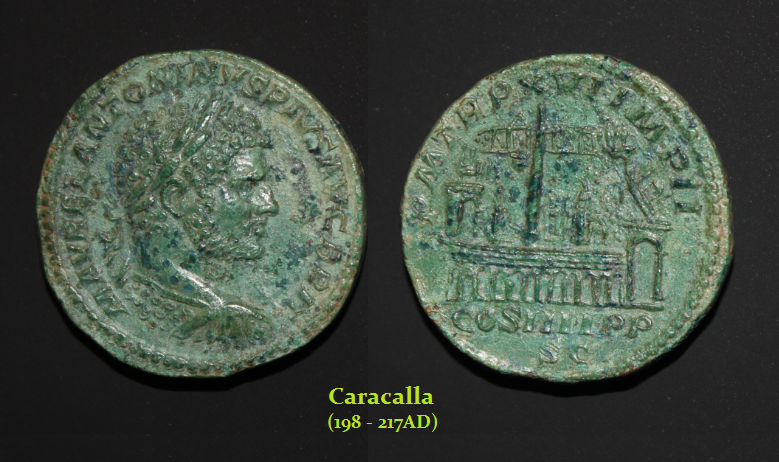 In 103AD, there was a catastrophic fire that destroyed much of the Circus Maximus. Trajan authorized an elaborate refurbishment and this was the first coin to display the Circus in its entirety. The arcaded façade, which received a marble facelift, and the extended grandstand in the background, allowed for five thousand extra spectators. The Arch of Titus once stood there separate from the one in the Forum, and can also be seen to the east. We can also see the Temple of Sol, surmounted by a bust of the deity. The most dominant feature of the overall design was the Flaminio Obelisk (today relocated in the Piazza del Popolo dating back to the Pharaoh Ramesses II. Towering over the track and spectators, the monument was so awe-inspiring that the later scholar Isidore of Seville adjudged it to be an ‘arrow running through the middle of the world’ (Etymologies, XVIII).
In 103AD, there was a catastrophic fire that destroyed much of the Circus Maximus. Trajan authorized an elaborate refurbishment and this was the first coin to display the Circus in its entirety. The arcaded façade, which received a marble facelift, and the extended grandstand in the background, allowed for five thousand extra spectators. The Arch of Titus once stood there separate from the one in the Forum, and can also be seen to the east. We can also see the Temple of Sol, surmounted by a bust of the deity. The most dominant feature of the overall design was the Flaminio Obelisk (today relocated in the Piazza del Popolo dating back to the Pharaoh Ramesses II. Towering over the track and spectators, the monument was so awe-inspiring that the later scholar Isidore of Seville adjudged it to be an ‘arrow running through the middle of the world’ (Etymologies, XVIII).
The historian Cassius Dio tells us that Trajan “was so high-minded and generous that, after enlarging and embellishing the Circus, which had crumbled away in places, he merely inscribed on it a statement that he had made it adequate for the Roman people.” (Roman History, LVIII.7.2). The seating was said to have accommodated 250,000 spectators. Unfortunately, a column near the top tier of the Circus Maximus seating area collapsed, killing perhaps 2,000 spectators instantly in 140AD. Reconstruction waited until the reign of Caracalla who then completed another renovation in 213AD.
Danube Bridge
Trajan’s most important building projects took place during the year 107 AD when he used the spoils from the Dacian conquest to build not merely Trajan’s Forum but also a new market similar to a two-story shopping mall of modern times. He also built Trajan’s Baths on the site of Nero’s Golden House and the Naumachia, which was a huge amphitheater for mock sea battles. He repaired and constructed many roads and bridges, which included a magnificent bridge across the Danube, which he proudly displayed on his coinage. He also repaired aqueducts throughout the entire Empire and constructed the last of the great aqueducts of Rome – the Aqua Traiana.
During the latter years of his reign, Trajan turned his attention to the eastern frontier focusing directly on the threat presented by the kingdom of Parthia. In 113 AD, Trajan set out to take both Armenia and Mesopotamia. His campaign was again successful in adding four new provinces to the Empire. In 115-116 AD, he penetrated into the heart of Parthia itself capturing its capital – Ctesiphon. By this time, revolts broke out in a number of provinces, including Judaea. The Jewish revolt in the east forced Trajan to withdraw from the Syrian capital of Antioch. He successfully put down the Jewish revolt and was then determined to return to Rome to direct operations for a new invasion of Parthia.
According to Cassius Dio, Trajan abandoned his campaign to increase the territory of Rome and consolidate that which he had already gained. Cassius relates that on looking out towards India, Trajan lamented that his age prevented him from following in the footsteps of Alexander (LXVIII 28.1). Cassius also tells us that Trajan began to suffer from circulatory problems. He appears to have suffered from a stroke, which left him partially paralyzed causing Trajan to suspect poison. Unfortunately, Trajan died en route to Rome at Selinus in Cilicia, in August of 117 AD. Trajan’s Column, which still stands in his expansion known as Trajan’s Forum in Rome, served perhaps as the resting place for his ashes in its base.
Trajan was a model Emperor who was often held in high regard and ranked alongside Augustus. By the fourth century, the Senate of Rome still prayed for their emperors using the words “More fortunate than Augustus and better than Trajan.” His reputation as a just, wise, and noble leader continued well into the Middle Ages when Dante gave him a place in Paradise.
Historians have always debated whether or not Trajan adopted an heir before he died. Many believe that his wife Plotina may have falsified the adoption of Hadrian, who had always been her favorite at court. The truth of this adoption could not be safely disputed by the Senate, however, and thus the acknowledged heir became Hadrian the next Emperor of Rome.
Correspondence between
Pliny the Younger &
Emperor Trajan
A remarkable pair of documents have survived from the correspondence between the Emperor Trajan and Pliny the Younger who was governor of Pontus/Bithynia from 111-113 AD. The following is a transcript of an exchange between these two famous individuals which offers great insight into the character and wisdom of both men. This exchange between the two men also provides a look into the Christian movement of the time and how it was regarded during the reign of Trajan.
Titles and Powers, 97-117 AD
AD Tribunician Power Imp. Acclamation Consul Other Titles
97 TR.P. CAESAR. GERM.
98 TR.P. (later TR.P.II) – IMP. COS.II. AVGVSTVS. P.M. P.P.
TR.P.III.
99 TR.P.IJI. – 1111.
100 TR.P.tIII. V. COS.III.
101 TR.P.V – VI. IMP.II. COS.IIII.
102 TR.P.VI. – VII. IMP.III. IMP.IIII. DACICVS.
103 TR.P.VII. – VIII COS.V. OPTIMV5 PRINCEPS
104 TR.P.VIII. – VIIII. IMP.V.
105 TR.P.VIIII. X.
106 TR.P.X. – XI. IMP.VI.
107 TR.P.XI. – XII.
108 TR.P.XII. – XIII.
109 TR.P.XIII. – Xliii.
110 TR.P.XIIII. – XV.
111 TR.P.XV. – XVI.
112 TR.P.XVI. – XVII. COS.VI.
113 TR.P.XVII. – XVIII.
114 TR.P.XVIII. – XVIIII. IMP.VII. OPTIMVS.
115 TR.P.XVIIII. – XX. IMP.VIII. – XIII. PARTHICVS.
116 TR.P.XX. – XXI.
117 TR.P.XXI.
Trajan first received his consulship in 91 AD. He received the tribunician power late in 97 AD. For a brief period following his accession, Trajan title remained as TR.P. However, soon afterwards, he decided to continue the dating system on his coinage as established by Nerva (TR.P.II.) and his title thus became TR.P.III. on September 18th, 98 AD. Thereafter, Trajan subsequently renewed his tribunician power each year on that date.
Monetary System

Mints: Rome & Asia Minor
Obverse Legends:
IMP CAES NER TRAJANO OPTIMO AVG GER DAC
IMP CAES NER TRAIANO OPTIMO AVG GER DAC PARTHICO PM TR P COS VI P P
IMP CAES NERVA TRAIAN AVG GERM P M
IMP CAES NERVAE TRAIANO AVG GER DAC PM TR P COS V PP
IMP TRAIANO AVG GER DAC PM TR P
IMP TRAIANO AVG GER DAC PM TR P COS VI PP
DENOMINATIONS
AU Aureus (6.54 grams)
AU Quinarius (4.61 grams)
AR Cistoporus
AR Denarius
AR Quinarius
AE Sestertius
AE Dupondius
AE As
AE Semis
AE Quadrans
AE Uncia
DARDANICUM MINES
Under Trajan and Hadrian, several series of bronze quadrantes were struck in the names of the imperial mines in Noricum, Dalmatia, Pannonia, and Moesia (Dardania). These operations supplied metal for the mint at Rome and perhaps were the sites of workshops to produce coinage for local circulation or as donatives. It has been suggested that these mine issues were struck at Rome itself, and served some unidentified function, much as the contemporary ‘nome’ coinage struck at Alexandria in Egypt. Whatever the circumstances, these pieces saw limited use, and except for one rare type struck by Marcus Aurelius, were not issued during any other period.
AE Semis (Dard. stg lf)
AE Quadrans (Dard. stg lf)
AE Quadrans (Laur hd rt/Moneta stg lf METALLI VLPIANI )
AE Quadrans (Laur hd rt/Aequitas)
AE Quadrans (Laur hd rt/Dardancia stg lf)
Colonial Issues
AR Tetdrachm (Caesarea)
AR Tridrachm (Caesarea) Laur rt/Asian gold rt)
AR Didrachm (Caesarea) Greek legends / Club DEMARCH EX VPATO
AR Drachm (Caesarea) Laurel hd rt/Horned Zeus rt
AR Hemidrachm (Caesarea) w/Zeus
AR Tetradrachm Antioch
AR Tetradrachm (Egypt)
Divvus Trajan issue by Hadian
AU Aureus (Bust rt/bust Hadrian rt)
AU Aureus (Laur rt/Phoenix standing rt)
Restoration of Trajan
Restoration Aureus of Tiberius by Trajan
In this interesting series, issued circa 107 AD, there are restorations of many of the Republican denarii as well as aurei beginning with Julius Caesar followed by the Emperors Augustus, Tiberius, Claudius, Galba, Vespasian, Titus, and Nerva.
The tradition of honoring previous men in history began during the Republican era when various contemporary men of position would mint coinage displaying the portrait of an honored ancestor. In many ways, such commemorative issues were also an attempt to distinguish themselves as honorable men by publicly displaying their heritage thus legitimizing their current political position.
In the case of Trajan, the extent of this series appears to have been intended to glorify the history of Rome by restoring Republican as well as Imperial coinage of the previous several hundred years.
Monetary System Restoration of Trajan
In the year 107AD, Emperor Trajan attempted to revitalize the money supply ordering that all the old coinage be “melted down all the worn-out coinage” according to the historian Cassius Dio. In essence, the treasury was greatly depleted due to his prolonged campaign to conquer Dacia, the modern-day Yugoslavia region. Trajan actually demonetized all silver and gold coinage that had been issued prior to the reign of Nero and his monetary reform of 64AD, which was the first step in the debasement. Therefore, Trajan was recalling all old “worn” coinage and reissuing it at a lower standard of his period.
At the time of Trajan, the finances of the Empire were in crisis. The fineness of the silver denarius when he came to power in 98AD was 93.5%. In 100AD, Trajan lowered the fineness to 92.75%. As the cost of the Dacian war escalated, he again reduced the fineness to 103AD to 91.5% This would decline further reaching 90% in 112AD.
Consequently, Trajan demonetized the old coinage which was of a heavier silver standard meaning they were no longer valid payment for taxes. This forced people to return them in exchange for new denarii. The old coins were then melted and in effect, this increased the money supply by about 10%.
Mints: Rome
DENOMINATIONS
AU Aureus (6.54 grams)
Julius Caesar
Augustus
Tiberius
Claudius
Galba
Vespasian
Titus
Nerva
AR Denarius (3.54 grams) Various issues from the Republic to Imperial pre-Nero

